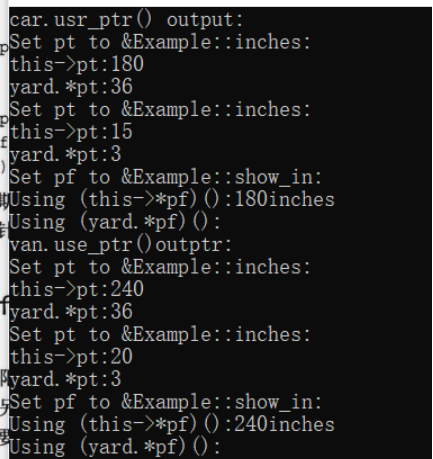这期内容当中小编将会给大家带来有关C++成员如何解除引用运算符,文章内容丰富且以专业的角度为大家分析和叙述,阅读完这篇文章希望大家可以有所收获。
下面看下成员解除引用运算符,C++允许定义指向类成员的指针,对这种指针进行声明或解除引用时,需要使用一种特殊的表示法。
例:
class Example{private: int feet; int inches;public: Example(); Example(int ft); ~Example(); void show_in()const; void show_ft()const; void use_ptr()const;};如果没有具体的对象,则inches成员只是一个标签。也就是说,这个类将inches定义为一个成员标识符,但要为它分配内存。必须声明这个类的一个对象:
Example ob;//现在ob.inches存在因此,可以结合使用标识符inches和特定的对象,来引用实际的内存单元(对于成员函数,可以省略对象名,但对象被认为是指针执行对象)。
C++允许这样定义一个指向标识符inches的成员指针:
int Example::*pt = &Example::inchers;这种指针与常规指针有所区别。常规指针指向特定的单元格,而pt指针并不是指向特定的内存单元,因为声明中没有指出具体的对象。指针pt指的是inches成员在任意Example对象中的位置。和标识符inches一样,pt被设计与对象标识符要求使用。实际上。表达式*pt对标识符inches的角色做了假设,因此,可以使用对象标识符来指定访问的对象,使用pt指针来指定该对象的inches成员。例如:类方法可以使用下面得的代码:
int Example::*pt = &Example::inches;Example ob1;Example ob2;Example *pq = new Example;cout<<ob1.*pt<<endl;//ob1对象的inches成员cout<<ob2.*pt<<endl;//ob2对象的inches成员cout<<po->*pt<<endl;//*po对象的inches成员其中,*和->*都是成员解除运算符,声明对象后,ob1.*pi指的将是ob1对象的inches成员,同样,pq->*pt指的是pq指向的对象的inxhes成员。
改变上述示例中使用的对象,将改变使用的inches成员。不过也可以修改pt指针本身。由于feet的类型与inches相同,因此可以将pt重新设置为指向feet成员(而不指向inches成员),这样ob1.*pt将是ob1的feet成员:
pt = &Example::feet;cout<<ob1.*pt<<endl;//*pt相当于成员名,可用标识(相同类型)其他成员可以使用成员指针标识成员函数,其语法稍微复杂的。对于不带任何参数、返回值为void的函数,声明一个指向函数的指针:
void (*pf)();//pf 指向函数声明指向成员函数指针时,必须指出该函数所属的类。例:
void (Example::*pf)()const;//pf指向类成员函数表明pf可用于使用Example方法地方。且Example::*pf必须放在括号中,可以将特定成员函数的地址赋给指针:
pf = &Example::show_inches;注意,与普通函数指针的赋值情况不同,这里必须使用地址运算符,完成赋值操作后,便可以使用一个对象来调用该成员函数:
Example ob3(20);(ob3.*pf)();//使用ob3对象调用show_feet()必须将ob3*p放在括号中,以明确地指出,该表达式表示的是一个函数名。
由于show_feet()原型与show_inches()相同,因此也可以使用pf来访问show_feet()方法:
pf = &Example::show_feet;(ob3*pf)();//将show_feet()应用于ob3对象例:
下面程序use_ptr()方法,使用成员指针来访问Example类的数据成员和函数成员。
#include <iostream>using namespace std;class Example{private: int feet; int inches;public: Example(); Example(int ft); ~Example(); void show_in()const; void show_ft()const; void use_ptr()const;};Example::Example(){ feet=0; inches=0;}Example::Example(int ft){ feet=ft; inches=12*feet;}Example::~Example(){}void Example::show_in()const{ cout<<inches<<"inches\n";}void Example::show_ft()const{ cout<<feet<<"feet\n";}void Example::use_ptr()const{ Example yard(3); int Example::*pt; pt=&Example::inches; cout<<"Set pt to &Example::inches:\n"; cout<<"this->pt:"<<this->*pt<<endl; cout<<"yard.*pt:"<<yard.*pt<<endl; pt=&Example::feet; cout<<"Set pt to &Example::inches:\n"; cout<<"this->pt:"<<this->*pt<<endl; cout<<"yard.*pt:"<<yard.*pt<<endl; void (Example::*pf)()const; pf=&Example::show_in; cout<<"Set pf to &Example::show_in:\n"; cout<<"Using (this->*pf)():"; (this->*pf)(); cout<<"Using (yard.*pf)():"; (yard.*pf);}int main(){ Example car(15); Example van(20); Example garage; cout<<"car.usr_ptr() output:\n"; car.use_ptr(); cout<<"\nvan.use_ptr()outptr:\n"; van.use_ptr(); return 0;}本例子在编译期间给指针赋值,在更为复杂的类中,可以使用指向数据成员和方法的成员指针。以便在运行阶段确定与指针关联的成员。

上述就是小编为大家分享的C++成员如何解除引用运算符了,如果刚好有类似的疑惑,不妨参照上述分析进行理解。如果想知道更多相关知识,欢迎关注编程网行业资讯频道。





